Approach
Early recognition of graft-versus-host disease (GVHD) is critical.
The diagnosis of GVHD is based primarily on clinical symptoms and manifestations.[79][80] Therefore, post-haematopoietic cell transplantation (HCT), all patients should undergo close monitoring and follow-up HCT comprising repeated physical examinations of all relevant organ systems, and interval history taking. The severity of involvement for each organ should be assessed and graded to inform prognosis and management.
Further investigations with laboratory tests, imaging studies, and tissue biopsies are recommended where indicated to support diagnosis and exclude other causes.[81] Guidelines on monitoring and follow-up (including further testing) have been published.[80][82]
Acute GVHD
The median onset of acute GVHD is typically 21-25 days after allogeneic HCT (although it is now recognised that acute GVHD can occur beyond the 100 days post-transplant that historically defined the disease).[1]
Factors in the history that may increase the likelihood of acute GVHD include: human leukocyte antigen (HLA) mismatch, older age of recipient or of donor, donor and recipient gender disparity (particularly a female donor with a male recipient), parous female donor, type and stage of the underlying malignant condition, transplant conditioning regimen intensity, absent or suboptimal GVHD prophylaxis. See Risk factors.
Commonly used scoring systems for grading acute GVHD include:
Mount Sinai Acute GVHD International Consortium (MAGIC) criteria[85]
The University of Minnesota Refined Acute GVHD Risk Score[86][87] [ The Minnesota Refined Acute GvHD Risk Score Opens in new window ]
See Diagnostic criteria.
Clinical manifestations of acute GVHD
The main organs affected in acute GVHD are the skin, gastrointestinal (GI) tract, and liver.[1]
Skin
The most commonly affected organ and generally the first to be affected. The presentation of skin involvement often coincides with donor cell engraftment and is characterised by an erythematous, maculopapular rash that is often pruritic.[Figure caption and citation for the preceding image starts]: Acute graft-versus-host disease (GVHD) of the skin (grade I)Courtesy of Dr John Levine, Professor, Blood and Marrow Transplantation Program, University of Michigan; used with permission [Citation ends].

In severe cases (stage 4), the skin may blister and ulcerate.
GI tract
GI involvement of GVHD may present as nausea, vomiting, anorexia, diarrhoea and/or abdominal pain.[88] It is a pan-intestinal process, often with differences in severity between the upper and lower GI tracts.
Diarrhoea is secretory and may be accompanied by significant GI blood loss as a result of mucosal ulceration, which is a prognostic factor for poor prognosis.[89] In advanced disease, diffuse, severe abdominal pain and distension is accompanied by voluminous diarrhoea.
Liver
Jaundice or hepatomegaly may be noted. The presentation may be difficult to distinguish from other causes of liver dysfunction following HCT, such as veno-occlusive disease/sinusoidal obstructive syndrome, drug toxicity, viral infection, sepsis, total parenteral nutrition cholestasis, or iron overload.
Isolated liver GVHD (i.e., with no other organs concurrently involved) is an uncommon finding.[90] Often a liver biopsy is required to establish the diagnosis. However, the increased risk of bleeding associated with thrombocytopenia in the immediate post-transplant period means that the diagnosis of isolated liver GVHD is often a diagnosis of exclusion.
Chronic GVHD
Classic chronic GVHD is not solely defined by any temporal relationship to HCT, although it usually occurs ≥100 days post-transplant. The reported median time to diagnosis is 4.5 months following HLA-identical sibling transplantation, and 4 months following unrelated donor transplantation.[22] De novo chronic GVHD almost never occurs ≥2 years post-allogeneic HCT.
Factors in the history that may increase the likelihood of chronic GVHD include: prior acute GVHD, older age of recipient or of donor, female donor with male recipient, parous female donor, use of peripheral blood stem cells, and donor lymphocyte infusion. See Risk factors.
Clinical manifestations of chronic GVHD
The potential clinical manifestations of chronic GVHD are many and varied, involving multiple organs and sites.
[Figure caption and citation for the preceding image starts]: Clinical manifestations of chronic graft versus host disease from the National Institutes of HealthCreated by BMJ Knowledge Centre [Citation ends].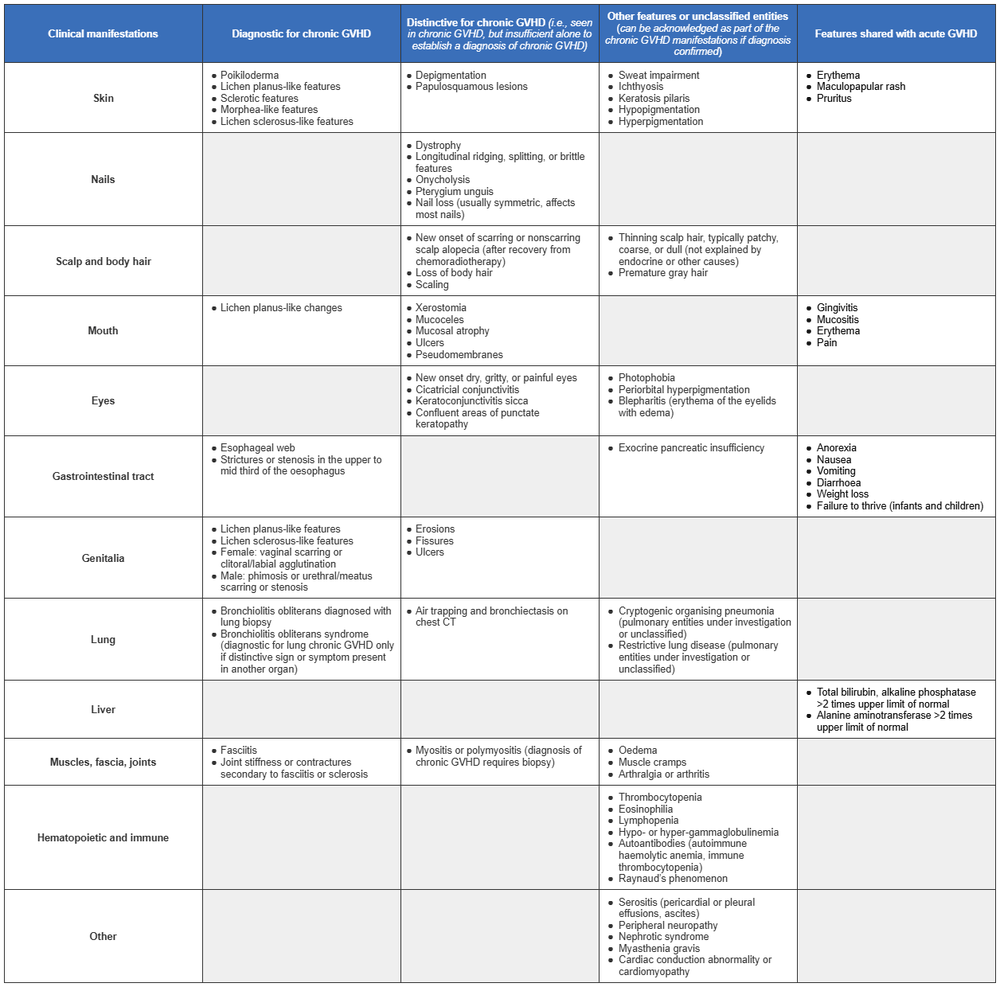
The National Institutes of Health (NIH) working group criteria recommend at least one diagnostic manifestation (e.g., oral or vaginal lichenoid findings, skin dyspigmentation, bronchiolitis obliterans), or one distinctive manifestation (e.g., ocular sicca, depigmentation, papulosquamous plaques) plus a pertinent biopsy, laboratory, or other test (e.g., radiographic and/or pulmonary test), for a diagnosis of chronic GVHD.[1]
Definitive diagnosis of chronic GVHD necessitates excluding other possible diagnoses such as infection, drug effects, malignancies, and residual post-inflammatory damage and scarring.[1] See Diagnostic criteria.
Laboratory studies
Certain laboratory study findings may be suggestive of GVHD, or help to exclude other causes of GVHD.
Full blood cell count
In the early post-transplant setting, cytopenia (particularly thrombocytopenia) may be associated with acute GVHD.
Autoimmune cytopenias (leukopenia, anaemia, and thrombocytopenia) may be seen at a later stage with chronic GVHD.
Eosinophilia may be present in acute or chronic GVHD.
Liver function tests
Elevated transaminases, alkaline phosphatase, and/or bilirubin may be a manifestation of acute and/or chronic GVHD.
Serum electrolytes
Acute and/or chronic GVHD affecting the GI tract (e.g., anorexia, nausea, vomiting, diarrhoea, weight loss, and failure to thrive [in infants and children]) can lead to a variety of electrolyte disturbances.
Urinalysis
Proteinuria may be a manifestation of renal dysfunction seen with nephrotic syndrome associated with chronic GVHD.
Blood culture
To exclude the possibility of bacteremia and/or sepsis.
Urine culture
To exclude the possibility of urinary tract infection.
Stool culture
Can help exclude potential infectious causes of diarrhoea that may closely resemble GVHD. However, positive stool studies and gastrointestinal GVHD can occur concurrently.
Viral polymerase chain reaction (PCR)
To test for infection with cytomegalovirus, HHV-6, adenovirus, hepatitis virus (A, B, C, D, E), and parvovirus. Viral infection forms one of the differential diagnoses of GVHD.
Imaging studies
Certain radiographic study findings may be suggestive of GVHD, or help to exclude other causes of GVHD.
High-resolution CT chest
Air trapping and bronchiectasis are distinctive features of chronic GVHD which may be evident on imaging.
Bilateral patchy ground-glass opacities with air bronchograms (usually located peripherally) or a circular nodule in one lung (or 3-5 nodules across both lungs) suggest cryptogenic organising pneumonia (COP). The triangle sign (a triangular ground glass opacity with the base on the pleura and the apex towards the mediastinum) is characteristic for COP.
CT abdomen
Luminal dilation with thickening of the small bowel wall (ribbon sign) and air-fluid levels suggestive of an ileus may be observed in GVHD affecting the GI tract.
Barium swallow
May reveal characteristic features of chronic GVHD of the GI tract such as oesophageal web, stricture, or concentric rings.
Doppler ultrasonography of the liver
Helpful to distinguish GVHD from other causes of liver dysfunction, such as cholecystitis and veno-occlusive disease/sinusoidal obstructive syndrome.
Hepatomegaly and ascites may be noted in GVHD.
18F-fluorodeoxyglucose positron emission tomography (FDG-PET) scan
FDG-PET scanning may be useful in localising GI tract GVHD, as well as predicting and monitoring treatment responsiveness.[91]
Biopsies
GVHD is a clinical diagnosis. A biopsy of the affected organ (e.g., skin, GI tract, liver, lung) may, however, be carried out to support or confirm a diagnosis, particularly if there is clinical uncertainty.[92]
Histopathological confirmation is also useful in excluding other conditions that may mimic GVHD.
Skin
The pathognomonic histopathological finding is apoptosis at the base of epidermal rete pegs. Other features include dyskeratosis, exocytosis of lymphocytes, satellite lymphocytes adjacent to dyskeratotic epidermal keratinocytes, and a perivascular lymphocytic infiltration in the dermis.[93][94][Figure caption and citation for the preceding image starts]: Histology of skin graft-versus-host disease (GVHD) (low power): Vacuolar interface dermatitis at the dermoepidermal junction with involvement of follicular epithelium (100x, haematoxylin and eosin)Courtesy of Dr Lori Lowe, Professor, Dermatopathology, University of Michigan; used with permission [Citation ends].
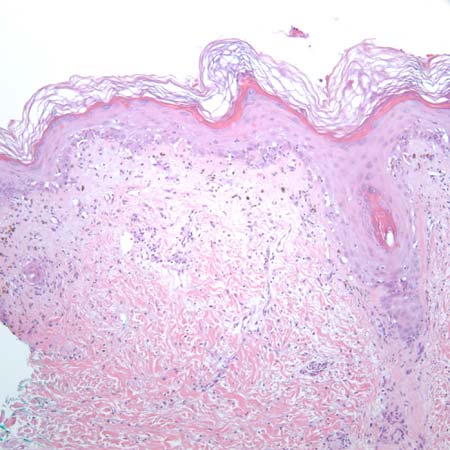 [Figure caption and citation for the preceding image starts]: Histology of skin graft-versus-host disease (GVHD) (high power): Vacuolar interface dermatitis with rare necrotic keratinocytes (200x, haematoxylin and eosin)Courtesy of Dr Lori Lowe, Professor, Dermatopathology, University of Michigan; used with permission [Citation ends].
[Figure caption and citation for the preceding image starts]: Histology of skin graft-versus-host disease (GVHD) (high power): Vacuolar interface dermatitis with rare necrotic keratinocytes (200x, haematoxylin and eosin)Courtesy of Dr Lori Lowe, Professor, Dermatopathology, University of Michigan; used with permission [Citation ends].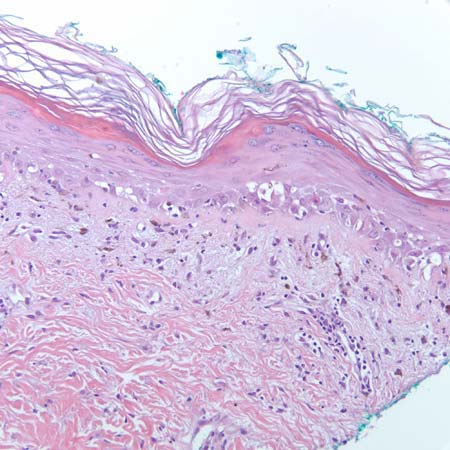
GI tract
Biopsy of the lower GI tract may be considered if there is diarrhoea.[92] An upper GI tract biopsy may be more appropriate if there is nausea and/or vomiting.[92]
Histological features include patchy ulcerations, apoptotic bodies in the base of crypts, crypt abscesses, and loss as well as flattening of the epithelium surface.[95][Figure caption and citation for the preceding image starts]: Histology of upper gastrointestinal graft-versus-host disease (GVHD) (medium-power photomicrograph of the stomach): Dilated gastric gland containing necrotic/apoptotic debris (arrow), typical of GVHDCourtesy of Dr Joel Greenson, Professor, Pathology, University of Michigan; used with permission [Citation ends].
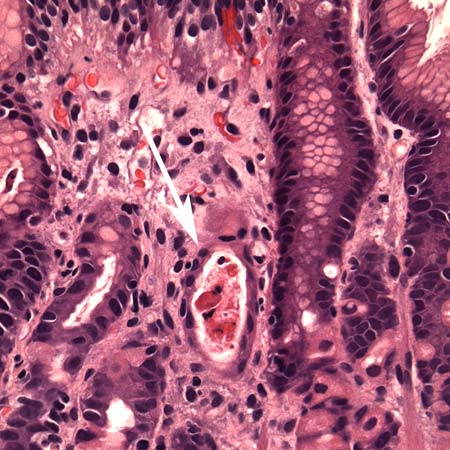 [Figure caption and citation for the preceding image starts]: Histology of lower gastrointestinal graft-versus-host disease (GVHD) (high-power photomicrograph of colon, mild disease): Numerous apoptotic bodies (arrows) indicative of GVHD involving the colonCourtesy of Dr Joel Greenson, Professor, Pathology, University of Michigan; used with permission [Citation ends].
[Figure caption and citation for the preceding image starts]: Histology of lower gastrointestinal graft-versus-host disease (GVHD) (high-power photomicrograph of colon, mild disease): Numerous apoptotic bodies (arrows) indicative of GVHD involving the colonCourtesy of Dr Joel Greenson, Professor, Pathology, University of Michigan; used with permission [Citation ends].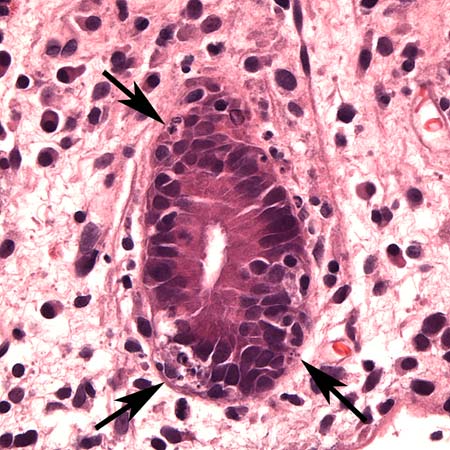 [Figure caption and citation for the preceding image starts]: Histology of lower gastrointestinal graft-versus-host disease (GVHD) (medium-power photomicrograph of colon, severe disease): Almost complete denudation of the mucosa indicative of severe GVHD involving the colonCourtesy of Dr Joel Greenson, Professor, Pathology, University of Michigan; used with permission [Citation ends].
[Figure caption and citation for the preceding image starts]: Histology of lower gastrointestinal graft-versus-host disease (GVHD) (medium-power photomicrograph of colon, severe disease): Almost complete denudation of the mucosa indicative of severe GVHD involving the colonCourtesy of Dr Joel Greenson, Professor, Pathology, University of Michigan; used with permission [Citation ends].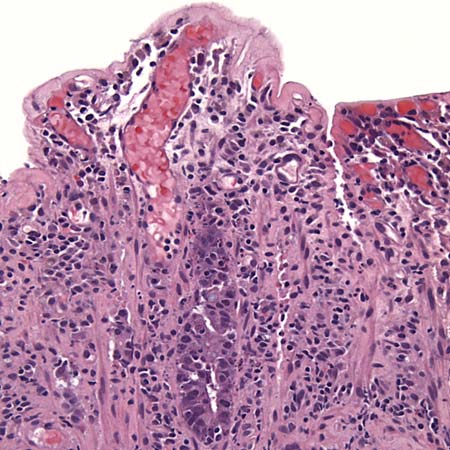
Liver
A liver biopsy may be considered to exclude other causes of liver dysfunction indicated (e.g., if liver function tests are abnormal).[92] The histological features supporting a diagnosis of acute liver GVHD include are endothelialitis, lymphocytic infiltration of the portal areas, pericholangitis, and bile duct destruction.[96][97] However, the increased risk of bleeding associated with thrombocytopenia in the immediate post-transplant period means that the diagnosis of liver GVHD is often a diagnosis of exclusion.
Lung
Histological features of bronchiolitis obliterans include small airway inflammation with fibrinous obliteration of the bronchiolar lumen.[98]
Other investigations
The following investigations may also help to guide diagnosis.
Pulmonary function tests (PFTs)
Used as a tool in identifying obstructive pulmonary disease (e.g., bronchiolitis obliterans) in chronic GVHD. Helpful in monitoring treatment response.
Bronchoscopy/bronchoalveolar lavage and culture
Can be helpful in assessing and excluding infection as a potential differential diagnosis of GVHD.
Upper GI endoscopy
May reveal features of gastrointestinal GVHD, such as oesophageal web, stricture, or concentric rings.
Echocardiogram
Helpful to detect pericardial effusions or cardiomyopathy.
Use of this content is subject to our disclaimer